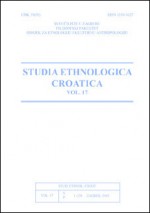Šamanizem na Slovenskem? Dileme o šamanizmu, obsedenosti in ekstazi
Shamanism on Slovenian Territory? Dilemmas Concerning the Phenomena of Shamanism, Spirit Possession and Ecstasy
Author(s): Žmago ŠmitekSubject(s): Customs / Folklore, Cultural Anthropology / Ethnology
Published by: Sveučilište u Zagrebu, Filozofski fakultet
Keywords: Shamanism; Animism; World tree; Spirit possession; Ecstasy;
Summary/Abstract: As a reaction to theories that attempted to find and prove »shamanistic tradition« in Europe (Meuli, Solymossy and their successors) there appeared certain more cautious, or even completely contradictory hypotheses of authors who maintained that shamanism should be distinguished from spirit possession. On the basis of Slovenian oral tradition, it is possible to assert that such a sharp differentiation is inappropriate. It is also clear, on the other hand, that any ecstatic state of a medium is not a sufficient argument that would prove the existence of shamanism. The author argues that there is a structure of elements that could be classified as shamanistic conceptions or notions (mythology, magic, iconography. etc.). An analysis of examples from Slovenia discovered certain pertinent comparisons with the Arctic area of Eurasia as well as the Indo-Iranian region. Slovenia and neighboring Croatia both share folk belief in the existence of the vedomec and/or the kresnik whose souls, be it voluntarily or because of a »higher power«, leave their bodies. In the clouds they fight their enemies for rain, drive away hail and bring abundant crops, health and happiness. These abilities and specific bodily characteristics make them similar to the benandanti from Friuli, Italy or the Hungarian tdltos. A veritable gallery of similar beings can be found in the Balkans as well. The name kresnik might have originated from the name krst, which in Macedonia and Serbia de-notes a stone sign that used to mark the boundaries of village territory. Vedomec might originate from the root ved-, which signifies a person of learning, the »one who sees and knows.« Equally interesting for comparison are Slovenian variants of stories about climbing the »world tree« with the aid of iron »claws« or axes, or the Slovenian tradition about the sacredness of hemp. All of this indicates an interrelation of different elements some of which could be labelled shamanistic.
Journal: Studia ethnologica Croatica
- Issue Year: 2005
- Issue No: 17
- Page Range: 171-198
- Page Count: 28
- Language: Slovenian

